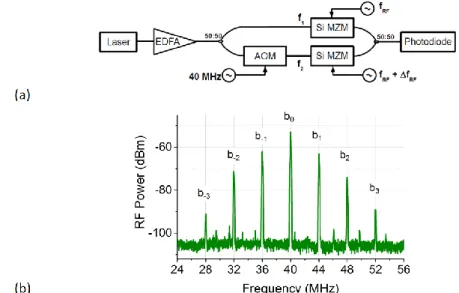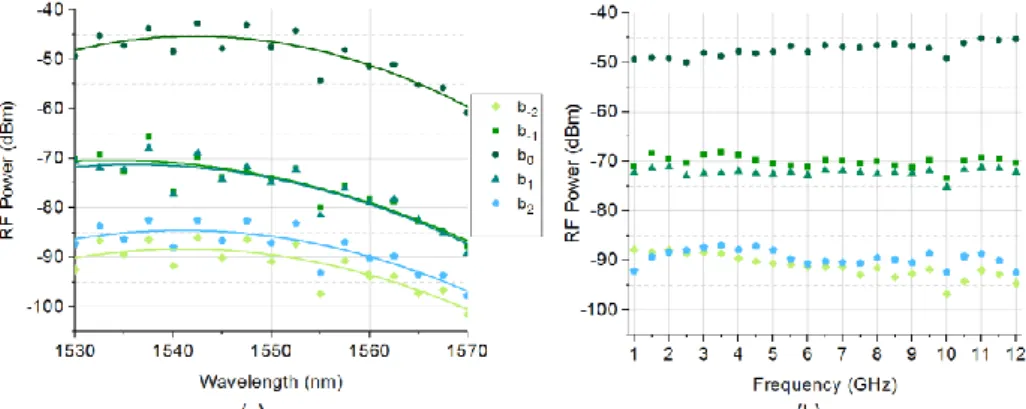HAL Id: hal-02946620
https://hal.archives-ouvertes.fr/hal-02946620
Submitted on 23 Sep 2020
HAL is a multi-disciplinary open access
archive for the deposit and dissemination of
sci-entific research documents, whether they are
pub-lished or not. The documents may come from
teaching and research institutions in France or
abroad, or from public or private research centers.
L’archive ouverte pluridisciplinaire HAL, est
destinée au dépôt et à la diffusion de documents
scientifiques de niveau recherche, publiés ou non,
émanant des établissements d’enseignement et de
recherche français ou étrangers, des laboratoires
publics ou privés.
Tunable optical dual-comb experiments using silicon
Mach- Zehnder modulators
Lucas Deniel, Erwan Weckenmann, Diego Galacho, Laurent Bramerie, Carlos
Alonso-Ramos, Fréderic Boeuf, Laurent Vivien, Christophe Peucheret,
Delphine Marris-Morini
To cite this version:
Lucas Deniel, Erwan Weckenmann, Diego Galacho, Laurent Bramerie, Carlos Alonso-Ramos, et al..
Tunable optical dual-comb experiments using silicon Mach- Zehnder modulators. 22nd European
Conference on Integrated Optics (ECIO 2020), Jun 2020, Paris, France. �hal-02946620�
Tunable optical dual-comb experiments using silicon
Mach-Zehnder modulators
(Student Paper)
Lucas Deniel1, Erwan Weckenmann2, Diego Pérez Galacho1,+, Laurent Bramerie2, Carlos Alonso-Ramos1, Fréderic Boeuf3, Laurent Vivien1, Christophe Peucheret2, Delphine Marris-Morini1
1 Université Paris-Saclay, CNRS, Centre de Nanosciences et de Nanotechnologies, 91120 Palaiseau, France 2 Univ Rennes, CNRS, FOTON - UMR 6082, F-22305 Lannion, France
3 ST Microelectronics, 850 rue Jean Monnet, 38920 Crolles, France
+ Now at ITEAM research institute, Universitat Politècnica de València, Camino de Vera s/n, 46022, Valencia,
Spain
e-mail: lucas.deniel@c2n.upsaclay.fr
ABSTRACT
Dual comb spectroscopy is a technique that simultaneously enables high signal-to-noise ratio and quasi-instantaneous measurements of optical spectra. It requires the generation of two mutually coherent optical frequency combs, and electro-optical modulation of a monochromatic carrier can be used for this purpose. By tuning the applied modulation frequency, it is possible to control the spacing between the lines of the electro-optical frequency combs (EOFCs), and by changing the input carrier frequency, it is possible to control the EOFCs absolute frequencies. On-chip EOFC generators are highly desirable to develop low-cost and low-weight dual-comb systems. In this context, silicon photonics is a promising technology, as it benefits from CMOS compatible fabrication process. In this work, a demonstration of dual-comb generation is performed, using two silicon Mach-Zehnder modulators. The tunablity of the obtained 5 main beat notes was studied for an input wavelength ranging from 1530 nm to 1570 nm, and for a driving modulation frequency between 1 GHz and 12 GHz.
Keywords: Dual-Comb, Silicon, Electro-optic, Modulators, Tunable. 1. INTRODUCTION
Optical frequency dual-comb experiments have raised a strong interest in the fields of spectroscopy and ranging [1-3], since these method enable high-speed and precise measurements of optical spectra. When two optical frequency combs with slightly different line spacings are combined and applied to a photodetector, the resulting beating products between the optical lines create a down-scaled image of the optical spectrum in the electrical radio-frequency (RF) domain. The generation of optical frequency combs (OFCs) can be achieved using mode-locked lasers, optical non-linearities in micro-resonators (microcombs), or by electro-optical RF modulation of a continuous wave (CW) laser beam. While in mode-locked laser based combs and in microcombs the OFC line spacing is linked to the cavity resonances, in the case of electro-optical frequency combs (EOFCs) the spacing between optical lines (or repetition rate) is determined by the frequency of the applied modulating signal. In addition, the EOFC central frequency is defined by the input laser source, and the generation of new lines is not limited by optical dispersion as for microcombs. Therefore, EOFCs are tunable, both in line spacing and in absolute frequency position, making them advantageous for dual-comb generation.
Integrated photonics allows the development of novel low-weight and small-footprint dual-comb generators for remote spectroscopy and ranging applications [4]. Being compatible with complementary metal-oxide semiconductors (CMOS) technology fabrication process and facilities, the silicon on insulator (SOI) platform is a suitable platform that permits a combination of photonic circuits with electronics [5].
This work presents an optical dual-comb experiment, where two EOFCs are generated using silicon Mach-Zehnder modulators (Si MZMs) based on free-carrier plasma dispersion effect, and an external acousto-optic modulator (AOM). The dual comb tunability is studied in terms of central wavelength and repetition rate.
2. MODULATOR DESIGN
The silicon Mach-Zehnder modulators used for the experimental demonstration were fabricated on STMicroelectronics 300-mm SOI technological platform [6]. A 4-mm long PN junction acting as a high-speed depletion based phase-shifter is embedded in each arm of a Mach-Zehnder structure, as shown in Fig. 1. Both PN
junctions are nested together: by connecting the N regions to the same electrical potential, the MZM is working in a single-drive push-pull operation. Electrical traveling wave electrodes are contacting the PN junction through highly doped regions, in order to reduce the access resistance. The rib waveguides are 300-nm high and 400-nm wide and the slab thickness is 50 nm.
Figure 1. Schematic top view of the silicon single-drive push-pull operating MZM.
The estimated attenuation factor in the phase-shifter is 1.24 dB/mm at 0-V bias, according to a numerical simulation based on Soref model. Static measurements of the MZM efficiency showed a half-wave voltage of V = 8 V, and a small signal electro-optical bandwidth of 18 GHz was measured for a -6 V bias of both diodes.
3. THE DUAL-COMB EXPERIMENTS 3.1 Principle and experimental generation.
The principle of dual-EOFC measurements consists in applying different RF signals with closely spaced frequencies fRF and fRF + fRF to each MZM, as shown in Fig. 2, to simultaneously produce and combine two
EOFCs with slightly different frequency spacings. In the resulting optical spectrum, lines of the first comb are found at frequencies f1 + n×fRF, where f1 is the input carrier frequency for the first comb, and n is the comb line
order, while lines of the second comb are found at frequencies f2 + n×(fRF + fRF), where f2 is the input carrier
frequency for the second comb. As a result, a line pair can be found for a given order n, and produces a beat note at the frequency (f2 - f1) + n×fRF after photodetection.
Figure 2. (a) Schematic of the experimental setup used for the dual-comb generation. A tunable external cavity laser emits a light beam at a 1.55 µm wavelength. After being amplified by the EDFA, the light beam is split in two paths. In one path, an AOM shifts the laser frequency
from f1 to f2=f1 + 40 MHz. Two EOFCs are then generated from the silicon MZMs, by applying 8-Vpp RF signals at fRF and fRF + fRF frequencies, respectively, to them. Both EOFCs are finally combined and applied to a high-speed photodiode. EDFA: erbium doped fiber
amplifier, AOM: acousto-optic modulator, Si MZM: silicon Mach-Zehnder modulator. (b) Beat notes experimentally measured on an electrical spectrum analyzer after photodetection, labelled with the letter b, numbered from -3 to +3.
As a first experimental demonstration, a dual comb is generated by applying two 22-dBm (8-VPP) RF signals
with frequencies fRF = 500 MHz and fRF + fRF = 504 MHz to the silicon MZMs. The input carrier frequency of
one MZM is shifted by 40 MHz by using an acousto-optic modulator, in order to distinguish beat notes originating from the nth order line pair from beat notes originating from the –nth order line pair. The obtained spectrum is displayed in Fig. 2(b). The retrieved electrical spectrum shows 7 beat notes labelled from b-3 to b3.
3.2 Study of the tunability
One of the main benefits of EOFCs is the possibility to tune the central frequency by changing the input laser wavelength, as well as tuning the line frequency spacings, by changing the modulating signal frequency. To study the comb tunability in absolute frequency, the external cavity laser source wavelength is swept from 1530 nm to 1570 nm, and the RF power of beat notes b-2 to b2 is measured at each step of 2.5 nm, as shown in Fig.
3(a). For this experiment, the modulation frequencies are fixed at 10 GHz and 10.004 GHz, and the applied RF input power is 25 dBm (11.2 VPP) on each modulator. The dots correspond to the measurements while the
continuous lines correspond to quadratic fits. Interestingly a similar evolution with the wavelength is seen for every beat-note, which is due to the grating couplers transmission. It can be noted that the accessible measurement range is limited by the bandwidth of the EDFA.
Figure 3. (a) RF power of the five main beat notes while the input wavelength is swept from 1530 nm to 1570 nm. The symbols correspond to the measurements while the continuous curves are quadratic fits. (b) RF power of the five main beat notes while the modulation frequency fRF
is swept between 1 and 12 GHz, the difference between both modulation frequency fRF being kept constant at 4 MHz.
The tunability in modulation frequency is then studied around a fixed wavelength of 1550 nm. The modulation frequency fRF is swept between 1 and 12 GHz (Fig. 3 (b)), while the slight difference between both
driving signals frequency is kept constant at 4 MHz. The highest frequency (12 GHz) is imposed by the driving RF amplifiers bandwidth.
The RF power applied to each MZM is set to 24 dBm (10 VPP). All beat notes appear steady over the scanned
range, which is compatible with a modulator electro-optical bandwidth of 18 GHz. These results prove the suitability of Si MZMs for EOFC-based dual comb applications.
4. CONCLUSIONS
Dual-comb experiments are reported, using EOFC generated from two silicon single-drive push-pull MZMs. 7 beat notes were observed in the electrical spectrum after photodetection. The dual-comb tunability in wavelength is tested between 1530 nm and 1570 nm, and is limited only by the bandwidth of the grating couplers and of the EDFA. Finally, a measurement of the 5 main beat notes is reported for a modulation frequency spanning from 1 GHz to 12 GHz, showing a good stability over this range. These results pave the way towards the use of silicon MZMs as low-weight and low-cost EOFC generators for flexible dual-comb applications.
ACKNOWLEDGEMENTS
This work has been partially funded by the Agence Nationale de la Recherche (ANR- 17-CE09-0041 MIRSPEC and ANR-18-CE39-0009 OBIWAM).
REFERENCES
[1] I. Coddington, et al.: Dual-comb spectroscopy, Optica, vol. 3. pp. 414-426, April 2016.
[2] N. Picqué, et al.: Frequency comb spectroscopy. Nat. Photonics, vol. 13. pp. 146-157, Feb. 2019.
[3] Z. Zhu, et al.: Dual-Comb Ranging. Engineering, vol. 4(6). pp. 772-778, Dec. 2018.
[4] A. Dutt, et al.: On-chip dual-comb source for spectroscopy. Sci. Adv., vol. 4 (3). pp. e1701858, March 2018.
[5] C. Weimann, et al.: Silicon photonic integrated circuit for fast and precise dual-comb distance metrology.
Opt. Express, vol. 25(24). pp. 30091-30104, Nov. 2017.
[6] C. Baudot et al.: Daphne silicon photonics technological platform for research and development on WDM applications, in Proc. SPIE 9891, 2016, 98911D.

